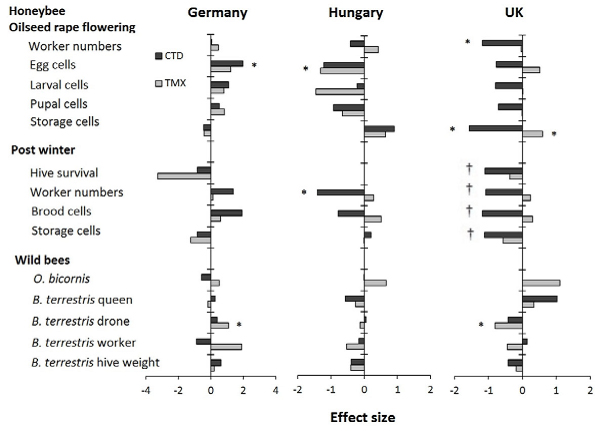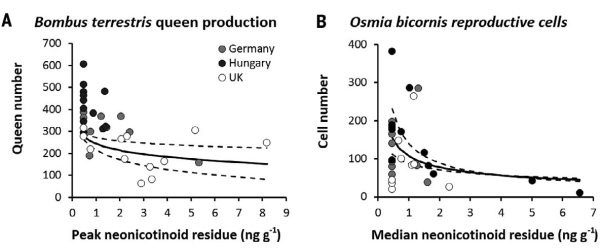The study involved a crop of winter-sown oilseed rape and looked at the impact of two neonicotinoids – Modesto (clothianidin) and Cruiser (thiamethoxam) on honeybees, a bumblebee and a solitary bee. The countries were Hungary, Germany and the UK.
NFU response
NFU Vice President Guy Smith said: “Both bees and farmers play a crucial role in producing food which is safe, affordable and high quality. Farmers rely on bees to pollinate crops and have planted around 10,000 football pitches of flower habitat across the country to support a healthy bee population and give them a good home – all because they recognise the key role they play. The oilseed rape crop itself is a great early source of food for them too.
“We strongly believe that policy decisions – such as restricting the use of neonicotinoids – must be based on sound science which gives strong evidence. And while this CEH study provides more useful information, we still don’t have that definitive evidence for the impact of neonicotinoids, and yet farmers and food production are hindered by restrictions on these products.
“Carrying out the task of producing food for the nation and the world depends very much on how healthy a crop is and how well we can protect it from pests. Insecticides – neonicotinoids in this case - are an important part of protecting not just oilseed rape but also crops such as cereals, sugar beet and vegetables. Without the tools to protect our crops, such as neonicotinoids which remain widely used all over the world, we risk simply importing food from other countries whose production standards we can’t control.”
Expert analysis
Below is expert analysis of the study from Professor Lin Field, from the internationally-renowned agricultural research institution Rothamsted Research, and Dr Chris Hartfield, the NFU’s bee health lead.
Rothamsted’s Professor Lin Field said: “My feeling is that no firm conclusions can be drawn from these results. This is perhaps not surprising given that there will be many complicated interactions between different neonicotinoids, different bee species and different field conditions.
“The results are very mixed. There are 42 comparisons of parameters measured with and without the seed treatments and of these 33 are not significant and therefore we can only conclude that the treatments had no effect. For those that are significant there are two positive effects in the results from Germany, three negative effects in Hungary – assuming that both CTD and TMX are significant – and three negative and one positive effect in the UK. None of these are consistently positive or negative for any one parameter.
“One of the worrying things about the data in Figure 3A is that if each country is looked at separately, Hungary shows a wide range of values for queen numbers with very little variation in nest residues, whereas the UK shows a wide range of residue levels but little variation in queen numbers. It is hard to interpret this.
“Overall most of the parameters tested show no significant differences and for those that do there are sometimes conflicting results, meaning that it is hard to draw any conclusions. The authors do make some comments on what the negative effects might mean for bee populations more widely but do not comment on the positive effects, which are hard to explain.”

Fig. 2. Summary effect sizes for the response of honeybees and wild bees to the neonicotinoid seed treatments. An effect size represents the difference between the mean population response for a given seed treatment and the control within a country, with this difference divided by the pooled standard deviation, where asterisk (*) indicates a significant difference between the control and seed treatment [either TMX (thiamethoxam) or CTD (clothianidin)] determined from the predicted marginal means of the model “y ~ seed treatment × country + block/country.” Dagger (†) indicates where U.K. colony survival was too low for a formal analysis. Note that effect sizes differ between countries.

Fig. 3. Wild bee reproductive success in response to neonicotinoid nest residues. Separate graphs are shown for the response of B. terrestris queen production and O. bicornis reproductive cell production to neonicotinoid residues found in nests. The significance of these relationships is based on a likelihood ratio test comparison of H0: “y ~ country” and H1: “y ~ neonicotinoid + country.” Neonicotinoid residues are based on summed concentrations of clothianidin, thiamethoxam, and imidacloprid. Expl.Var, explained variance.
Dr Chris Hartfield, NFU lead on bee health, said: “The NFU has called for large scale field trials like these to be done to try and resolve the question of whether harmful effects seen in artificial-feeding studies actually occur in real fields, to the extent where neonicotinoids could be causing widespread decreases in bee populations.
“The largest result from this study is that for over 75% of the parts of bee life cycle measured, the neonicotinoid seed treatments had no significant effect at all. Where significant effects did occur, there was an inconsistent range of negative and positive effects of neonicotinoid use on bee health. The study found negative effects of neonicotinoids on bees in Hungary and the UK, and positive effects on bees in Germany and the UK. If neonicotinoids were as bad as some make out, their impact would not respect geographical boundaries. There would be clear and similar impacts in every country and every field where neonicotinoids were used. This study clearly shows this is not the case.
“The report makes clear these effects are not consistent across countries and suggests this is because there are many interacting environmental factors that impact on bees, not just neonicotinoids. I think this also indicates that effects of neonicotinoids, if they occur at all, are small and can be overridden by other factors, such as plentiful food resources and good colony health.
“This study does not show that neonicotinoids are causing widespread declines in bee populations – particularly given that it shows positive as well as negative effects of neonicotinoids on bees, and in the majority of cases there is no effect at all. And let’s not forget the wider backdrop that it is still the case that the evidence shows the most significant declines in bee biodiversity in the last century actually predate the use of neonicotinoids by decades. More recently – during the time neonicotinoids have been used – there has been a slowdown in the rate of decline in bumblebee biodiversity in the UK, and also some increases in solitary bees in Great Britain.”
